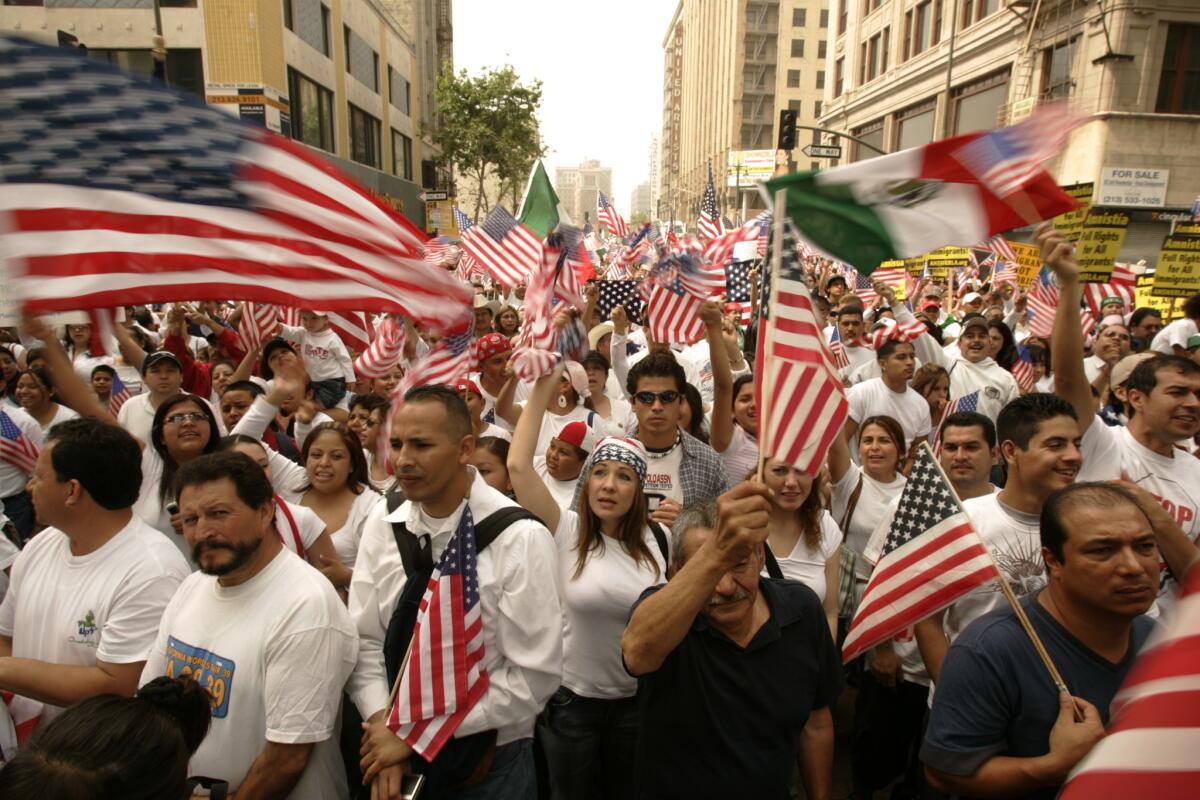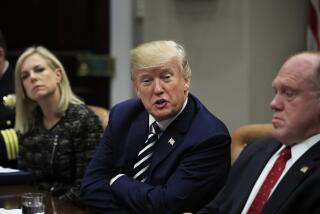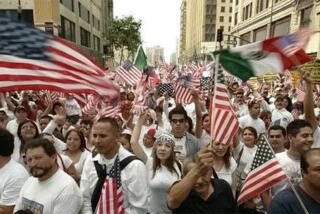Could anger over Donald Trump’s rhetoric reinvigorate the push for immigration reform? Advocates hope so

A decade ago, Anabel Garcia Romo, then a 17-year-old attending Garfield High School, took part in the epic May Day march through the streets of downtown Los Angeles.
She was drawn to the protest because she had friends and family who were in the country illegally and she opposed a proposal in Congress that would have made them felons.
Garcia called the day a defining moment in her life. But in the years since, nothing — not even Donald Trump — has compelled her back to the streets.
“The day kind of came and passed like nothing for me,” she said. “I think I was more concerned with the second episode of [this season of] ‘Game of Thrones’ than May Day.”
See more of our top stories on Facebook >>
That 2006 march — with more than half a million people showing up — was by some measures the largest immigration protest in U.S. history, and many saw it as the beginning of a bigger social movement.
But that didn’t happen. The controversial legislation that inspired it was killed. The larger efforts at immigration reform also faltered, and the promised new era of Latino activism appeared to lose some of its vigor.
Enter Donald Trump, who has made attacks on Mexican immigrants and building a border wall a centerpiece of his presidential campaign. Trump faced disruptive protests when he rallied in California several weeks ago. But the numbers were small compared to the huge protests of the past.
And many people both inside the movement and who study it question whether Trump’s rhetoric alone is enough to reignite the passions of the past.
“There would have to be another imminent threat or federal anti-illegal immigration legislation,” said Chris Zepeda-Millán, a political scientist in the Department of Ethnic Studies at UC Berkeley. “This is why people protest. People protest against something — not for something.”
------------
FOR THE RECORD
May 25, 1:07 p.m.: An earlier version of this article identified Chris Zepeda-Millán as a UC Berkeley professor of political science. He is a political scientist in the Department of Ethnic Studies at UC Berkeley.
------------
The next test will come Wednesday, when Trump will hold a rally in Anaheim. While some activist groups plan to be out in force, few expect mass rallies there or when he speaks Friday in San Diego.
Garcia said the one thing that would probably motivate her to protest again would be if Trump were to become president.
Zepeda-Millán, who studies the effects of the 2006 protest wave, said although significant legislation hasn’t passed on a national level, the mass mobilization eventually led immigrant rights activists to refocus their efforts toward the 2008 election to help elect the nation’s first African American president. The hope was that Obama would use his political capital to pass some sort of immigration reform that would legalize the more than 11 million in the country without legal status. Instead, his legacy among immigrant rights circles is one of a record number of deportations, winning him the label of “deporter-in-chief.”
For now, Zepeda-Millán said protests are not necessary. Instead, he said, he believes Latinos will just take their concerns to the ballot box.
There are indications that Trump’s candidacy is helping spur an uptick in naturalization applications. U.S. Citizenship and Immigration Services data show an increase in applications filed between June, when Trump announced his candidacy, and January, compared with the same period in recent years.
Data from previous years show that applications tend to increase when anti-illegal immigration efforts gain the spotlight, such as Proposition 187, a 1994 initiative resoundingly approved by California voters — later legally struck down — that would have denied most public services to those in the country illegally, including children.
In 2006, immigrant rights organizers were hopeful after millions took to the streets against the Sensenbrenner bill, which would have made it a felony to be in the country illegally as well as to offer humanitarian assistance to someone in the country without legal status.
Garcia said she had expected more change to come from the massive protests. Afterward, she became more heavily involved in organizing around immigrant rights, but eventually became disillusioned.
“We were all waiting for something to happen. We were waiting for the movement to create some change and it didn’t. The only thing it did was manage to stop the bill,” she said.
Instead, every few years, immigration reform would get close to passage only to be defeated. Some immigrant rights leaders got burned out and dropped out of the movement. Not as many people showed to May Day rallies in the years going forward.

When Garcia’s immigrant rights group proposed non-peaceful actions, she said she decided to exit.
“There was a difference of opinion on how to move forward,” she said.
Many youths stayed and took the reins of the movement, participating in more bold tactics to call attention to their cause — from participating in sits-ins at congressional offices to even “self deportation.” Sometimes their strategies were met with unexpected consequences, such as a dissent within the movement — especially among old-guard traditional activists afraid of alienating establishment allies.
However, it was the sit-ins, acts of disobedience and other in-your face tactics by young immigrant rights leaders that helped spark President Obama’s executive action in 2012, which shielded a group of young immigrants from deportation and gave them work permits. It’s the most significant immigration move in the last 30 years.
But the immigration relief is temporary and could be overturned by the next presidential administration. An extension of the program that includes the parents of U.S. citizen children is also stuck in the courts.
The recent incarnation of the immigrant rights movement is relatively young, and it generally takes several decades to see substantial results, Zepeda-Millán and other experts contend. Ten years from now, they said, it’s quite possible that immigration reform will come to pass and the 2006 marches will be credited as a pivotal moment.
But in the meantime, some experts say that Latino activists have yet to come up with a strategy to move forward.
“It’s a lost decade,” said Roberto Gonzales, a Harvard University sociologist who studies immigration. “I think the big question moving forward ... is what is the strategy?”
Two years ago, an immigrant rights protest in Washington, D.C., that included blocked traffic and arrests gained national headlines.
When a group of religious leaders marched down the streets of downtown L.A. chanting “We Shall Overcome” during Holy Week earlier this year, they hoped to generate attention to their cause by blocking traffic in front of the federal immigration courthouse. They formed a circle and were arrested after refusing to budge.
But the publicity they hoped their protest would generate was not forthcoming.
The muted response to the action was indicative of what many are describing as a stalemate in the immigration debate, where the escalating rhetoric from the right and protests from the left became the steady routine of an issue where opinions have become entrenched -- with neither side really getting what it wants.
No massive, impenetrable wall has been built and the mass deportations of millions in the country illegally desired by some have not materialized. But neither has comprehensive immigration reform.
“You escalate and you escalate and you build power, but then what?” asked Noel Andersen, a grassroots coordinator with the Church World Service who helped organize both the Washington, D.C., and Los Angeles protests.
Three years ago, Lizbeth Mateo was part of a group of immigrants who “deported” themselves to Mexico and then demanded to be let back into the United States during an unorthodox demonstration at the Arizona border that was criticized by some advocates. Soon after, she took a break from organizing to focus on school, graduating from Santa Clara University in May.
For Mateo, the focus on Trump detracts from the attention on the Obama administration’s handling of Central American mothers and children who are currently in immigration detention. She hopes that the outrage toward the billionaire Republican candidate can be channeled toward the current administration.
“If we can build an entire campaign around Trump, why the hell can’t we do that around children who are being detained?” Mateo said. “Why are we not holding the Democrats accountable? If we cannot hold our so-called friends accountable, how are we going to hold our enemies accountable?”
Gloria Carrasco, a 55-year-old who lives in Los Alamitos, joined the May Day protests this year, marching with the American flag over her neck as a scarf.
Looking back, she expected that dramatic immigration reform would have happened by now, giving people such as her legal immigration status. Instead, time passed and her father fell ill and then died in Mexico, leaving her to mourn from a distance. Carrasco said she’s disappointed by the rise of Trump and what she sees as a lessening of the spirit that inspired hundreds of thousands, including herself, to protest in the streets 10 years ago.
Although she can’t vote, she has approached all her friends and family members who are eligible to register to vote and show up on election day. She begs them to cast a vote against Trump.
“I urge them to participate. They have to vote,” she said. “He cannot be president.”
CAMPAIGN 2016
With Trump to speak in Anaheim, police brace for protests
Bernie Sanders is a socialist? Some on the far left say ‘sellout’ is more like it
Protesters clash with police outside Trump rally in Albuquerque; authorities call it a riot
Twitter: @thecindycarcamo
More to Read
Start your day right
Sign up for Essential California for news, features and recommendations from the L.A. Times and beyond in your inbox six days a week.
You may occasionally receive promotional content from the Los Angeles Times.







